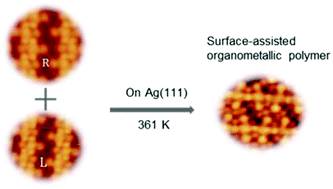Organometallic polymers synthesized from prochiral molecules by a surface-assisted synthesis on Ag(111)
Abstract
Organometallic polymers can be successfully synthesized on a Ag(111) surface via a surface-assisted synthesis by choosing prochiral 4,4′-dibromo-2,2′-bis(2-phenylethynyl)-1,1′-biphenyl (DBPB) molecules as the designed precursor. High-resolution scanning tunneling microscopy investigation reveals that prochiral molecules show chirality on a surface and can evolve into organometallic chains on the Ag(111) surface based on Ullmann coupling. Due to the special structural features of DBPB molecules, chiral selectivity will be lost in the organometallic polymers. This result may provide an important basis for selecting suitable precursors to fabricate chiral covalent nanostructures on a surface.



 Please wait while we load your content...
Please wait while we load your content...